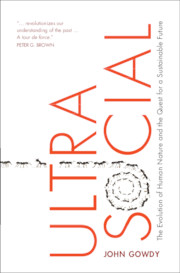Book contents
- Ultrasocial
- Reviews
- Ultrasocial
- Copyright page
- Dedication
- Contents
- Figures
- Tables
- Preface
- Acknowledgments
- Part I The Evolution of Human Ultrasociality
- 1 The Ultrasocial Origin of Our Existential Crisis
- 2 The Evolution of Ultrasociality in Humans and Social Insects
- 3 Our Hunter-Gatherer Heritage and the Evolution of Human Nature
- 4 The Agricultural Transition and How It Changed Our Species
- Part II The Rise and Consolidation of State/Market Societies
- Part III Back to the Future
- Notes
- References
- Index
2 - The Evolution of Ultrasociality in Humans and Social Insects
from Part I - The Evolution of Human Ultrasociality
Published online by Cambridge University Press: 09 October 2021
- Ultrasocial
- Reviews
- Ultrasocial
- Copyright page
- Dedication
- Contents
- Figures
- Tables
- Preface
- Acknowledgments
- Part I The Evolution of Human Ultrasociality
- 1 The Ultrasocial Origin of Our Existential Crisis
- 2 The Evolution of Ultrasociality in Humans and Social Insects
- 3 Our Hunter-Gatherer Heritage and the Evolution of Human Nature
- 4 The Agricultural Transition and How It Changed Our Species
- Part II The Rise and Consolidation of State/Market Societies
- Part III Back to the Future
- Notes
- References
- Index
Summary
The term ultrasocial refers to those complex human and social insect societies that actively manage the cradle-to-grave production of the food they depend on. Contemporary theoretical concepts in evolutionary biology – including group selection, epigenetics, and social evolution – help to understand the transition to ultrasociality. Twentieth-century biology was dominated by a gene-centric view of evolution and natural selection. Today, biologists and social scientists are applying the basic principles of Darwinian evolution – selection, variation, and inheritance – at multiple levels. The recognition that Darwinian natural selection need not be gene based opens the door for a rigorous analysis of the common factors in the transformative evolution of humans and social insects that came with agriculture. Concepts of group selection can be successfully applied to understand how and why differentiated social structure and social complexity evolved. For humans and other ultrasocial animals, the evolution of complexity was propelled by their ability to produce surplus food. Basic economic laws drove the evolution of this major evolutionary transition.
- Type
- Chapter
- Information
- UltrasocialThe Evolution of Human Nature and the Quest for a Sustainable Future, pp. 17 - 40Publisher: Cambridge University PressPrint publication year: 2021



